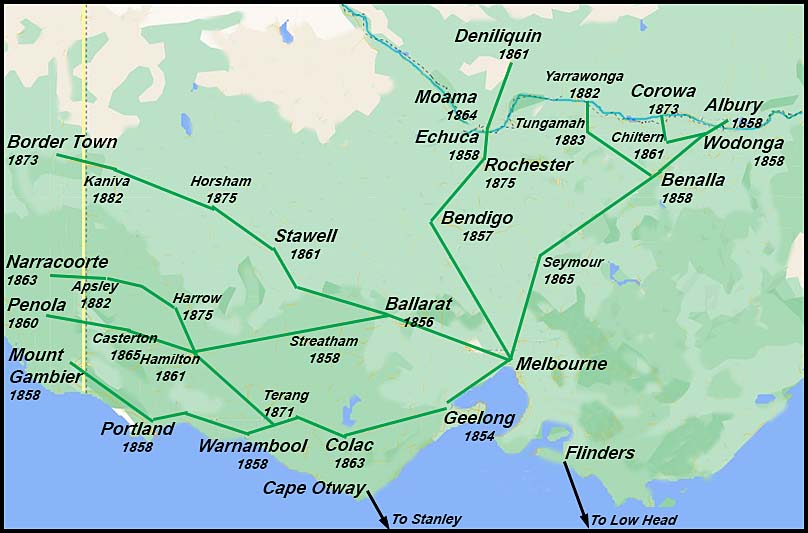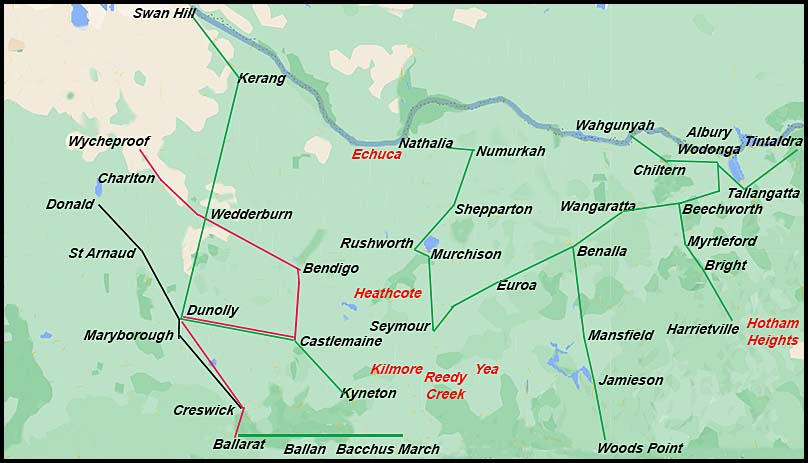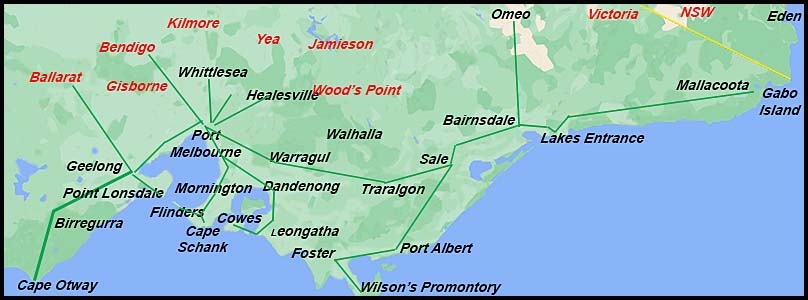- Australia 1901-1988
- New South Wales
- Queensland
- South Australia
- Tasmania
- Victoria
- Western Australia
- International
- Special aspects
The construction of the telegraph lines up until about 1900 is described as follows:
- first line to Williamstown - Geelong - Ballarat - Bendigo;
- first lines to South Australia;
- first line to New South Wales;
- first cable to Tasmania;
On 10 November 1853, Samuel McGowan was instructed by Governor C. J. La Trobe "to proceed with the construction of a line of electric telegraph to connect Melbourne and Williamstown". That undertaking was successfully completed in March 1854.
In September 1854, an extension of that line was commenced and, by December, communication with Geelong was opened with Queenscliff,at the Heads, following in January 1855. A Branch line to Sandridge was opened in July 1855. With the successful demonstration of the possibility of communication by telegraph in Victoria, further lines were planned and constructed almost immediately.
By the end of 1857:
- the line through Beechworth to Belvoir/Albury had been completed;
- the line through Ballarat, Fiery Creek, Hexham, Warrnambool and Portland had been completed and was ready to connect to Mount Gambier in South Australia.
From that time on, McGowan supervised construction at a rapid rate to meet a range of Government economic and social policy priorities. By the end of 1860, 36 Telegraph Offices had been opened plus offices at Albury and Mount Gambier in the neighbouring Colonies.
The assignment of Telegraph Offices to lines.
Telegraph Offices were opened along the lines so that messages could be sent with maximum efficiency. Sometimes it became more efficient to reallocate an Office to a different line as additional constructions were completed. Indeed, as line constructions progressively covered most of Victoria and newer technology facilitated switching between lines more easily, more lines were created - many with only a few Offices on them. Naming these lines also changed over time and three approaches evolved over time:
- Approach 1:
- The definition of lines from 1861 used compass directions (e.g. Western or Adelaide line) and broad descriptions (e.g. Cross Country, Western Coast, etc) as well as Branch line names (e.g. Birregurra Branch or Rushworth Branch). In 1861, there were 50 Telegraph Offices (see Appendix C in the Report for 1861).
- Approach 2:
- With the number of Telegraph Offices increasing rapidly (261 in 1879 across 3,156 miles of wire) a more geographically oriented naming system had to be introduced - especially as Offices in a given locality were linked. In 1884, a new classification approach was used to reflect the purposes of the lines as well as to incorporate more recent additions to the network. It is that approach which is used to guide the discussion of Victorian lines in this website. It is a suitable "half-way point". These line names are used in the Listing of Victorian Telegraph Offices.
- Approach 3:
- By 1890 - after lines had been reclassified again to reflect improved networking as the result of better switching equipment - a final classification system was introduced. It had 211 lines (including some for telephones only) covering 8,720 miles of wire. Offices along these lines are summarised at the end of each page of the Telegraph lines discussed (using Approach 2).
Details of the construction of the lines and the Telegraph Offices involved (generally to about 1890 but some later) can be accessed from the lmaps and tables below:
1. Lines in and around Melbourne
 |
| Name of line | Branch lines | Telegraph Offices (1884). |
| Mount Gambier Line | Geelong - Warnambool - Portland - Mount Gambier |
TOs |
| Penola Line. | Geelong Terang - Hamilton - Penola. | TOs |
| Narracoorte Line. | Ballarat - Streatham - Hamilton - Narracoorte | TOs |
| Bordertown Line. | Ballarat - Stawell - Kaniva - Border Town | TOs |
| Albury Line. (No. 1 & No. 2 N.E.) |
Seymour - Benalla - Wodonga. |
TOs |
| Heathcote | TO | |
| Reedy Creek | TO | |
| Yea | TO | |
| Tintaldra | ||
| Corowa (Wahgunya) line. | Wodonga - Chiltern - Corowa | TOs |
| Echuca-Deniliquin line. (No. 3 North) |
Bendigo - Rochester - Echuca - Deniliquin. | TOs |
| Tasmania | 1859 cable Cape Otway to Stanley. | |
| 1869 ++ cables Flinders to Low Head. |
3. Other lines above Melbourne.
 NOTE: Lines come back to Melbourne from Bacchus Marsh and from Seymour via Kilmore. |
| Line | Sample telegraph stations | Telegraph Offices |
| Donald | Donald - Maryborough - Creswick | TOs |
| Wycheproof | Wycheproof - Bendigo - Ballarat | TOs |
| Swan Hill | Swan Hill - Kerang - Dunolly - Kyneton | TOs |
| Goulburn Valley | Seymour - Rushworth - Nathalia | TOs |
| Wood's Point | Seymour - Benalla - Jamieson - Woods Point | TOs |
| Ballarat No 8 West (and branches) |
Ballarat - Ballan - Melton | TOs |
| Branches from the Albury line. | To Heathcote, to Reedy Creek and to Yea. | TOs |
| Albury - Tallangata - Tintaldra |
4. Lines near and east of the Melbourne.
 |
| Name of Line | Sample telegraph stations | Telegraph Offices |
| Otways | Geelong - Birregurra - Cape Otway | TOs |
| Southern Coast | Point Lonsdale - Port Melbourne - Mornington - Flinders. | TOs |
| Cowes | Dandenong - Cowes | TOs |
| Melbourne - NE lines |
Preston - Yan Yean - Whittlesea | TOs |
| Heidelberg - Kangaroo Ground | ||
| Kew - Box Hill - Healesville | ||
| Gippsland | Dandenong Warragul - Traralgon - Sale | |
| Sale to Bairnsdale and Omeo; | TOs | |
| Lakes Entrance to Snowy River and Mallacoota; | TOs | |
| South Gippsland; | TOs | |
| Gabo Island. | TO |